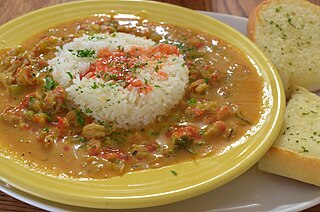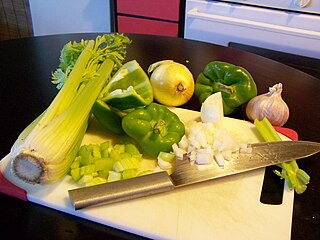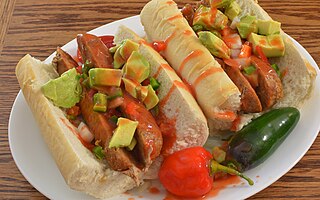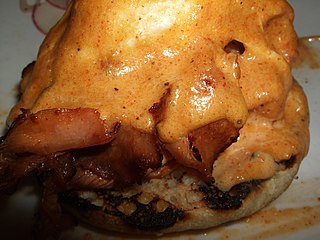 W
WCajun cuisine, is a style of cooking developed by the Cajun–Acadians who were deported from Acadia to Louisiana during the 18th century and who incorporated West African, French and Spanish cooking techniques into their original cuisine.
 W
WBlackening is a cooking technique used in the preparation of fish and other foods. Often associated with Cajun cuisine, this technique was popularized by chef Paul Prudhomme. The food is dipped in melted butter and then sprinkled with a mixture of herbs and spices, usually some combination of thyme, oregano, chili pepper, peppercorns, salt, garlic powder and onion powder. It is then cooked in a very hot cast-iron skillet. The characteristic brown-black color of the crust results from a combination of browned milk solids from the butter and charred spices.
 W
WBoudin are various kinds of sausage in French, Luxembourgish, Belgian, Québécois, Acadian, Aostan, Louisiana Creole and Cajun cuisine.
 W
WCourt-bouillon or court bouillon is a quickly-cooked broth used for poaching other foods, most commonly fish or seafood. It is also sometimes used for poaching vegetables, eggs, sweetbreads, cockscombs, and delicate meats. It includes seasonings and salt but lacks animal gelatin.
 W
WCrawfish pie is a type of baked savory pie common in the Cajun and Creole cuisine of Louisiana. It is similar in appearance to a pot pie and contains crawfish. The dish is mentioned in the Hank Williams song "Jambalaya ", along with other common Cajun dishes such as the eponymous jambalaya and gumbo.
 W
WDirty rice is a traditional Louisiana Creole dish made from white rice which gets a "dirty" color from being cooked with small pieces of pork, beef or chicken, green bell pepper, celery, and onion, and spiced with cayenne and black pepper. Parsley and chopped green onions are common garnishes. Dirty rice is most common in the Creole regions of southern Louisiana; however, it can also be found in other areas of the American South and referenced as "chicken and rice" or "rice dressing".
 W
WÉtouffée or etouffee is a dish found in both Cajun and Creole cuisine typically served with shellfish over rice. The dish employs a technique known as smothering, a popular method of cooking in the Cajun and Creole areas of southwest Louisiana. Étouffée is most popular in New Orleans and in the Acadiana area of the southernmost half of Louisiana as well as the coastal counties of Mississippi, Alabama, northern Florida, and eastern Texas.
 W
WFricassee or fricassée is a stew made with pieces of meat that have been browned in butter that are served in a sauce flavored with the cooking stock. Fricassee is usually made with chicken, veal or rabbit, with variations limited only by what ingredients the cook has at hand.
 W
WGumbo is a soup popular in the U.S. state of Louisiana, and is the official state cuisine. Gumbo consists primarily of a strongly-flavored stock, meat or shellfish, a thickener, and the Cajun/Creole "holy trinity" ― celery, bell peppers, and onions. Gumbo is often categorized by the type of thickener used, whether okra or filé powder.
 W
WThe holy trinity in Cajun cuisine and Louisiana Creole cuisine is the base for several dishes in the regional cuisines of Louisiana and consists of onions, bell peppers and celery. The preparation of Cajun/Creole dishes such as crawfish étouffée, gumbo, and jambalaya all start from this base.
 W
WA hot link, also referred to as a "red link," is a type of sausage often associated with the cuisine of the Southern United States, featured commonly as a part of American barbecue, soul food, and Cajun and Louisiana Creole cuisines. It is sometimes referred to as a "Louisiana hot link". It is also a part of Texan cuisine and the cuisine of Chicago, Illinois. The hot link is usually prepared using pork, beef, or a combination of both. It is sometimes used as an ingredient in other dishes, such as jambalaya and gumbo. Hot link sausages are mass-produced by some companies in the United States.
 W
WJambalaya is a Creole rice dish of West African, French, and Spanish influence, consisting mainly of meat and vegetables mixed with rice. Traditionally, the meat always includes sausage of some sort, often a smoked meat such as andouille, along with pork or chicken and seafood, such as crawfish or shrimp. The vegetables are usually a sofrito-like mixture known as the "holy trinity" in Cajun cooking, consisting of onion, celery, and green bell pepper, though other vegetables such as okra, carrots, tomatoes, chilis and garlic are also used. After browning and sauteeing the meat and vegetables, rice is added with seasonings and broth, and the entire dish is cooked together until the rice is done.
 W
WRice and gravy is a staple of Louisiana Creole and Cajun cuisine, made by deglazing a pan to make brown gravy, simmered with extra seasonings, and served over steamed or boiled rice.
 W
WSmothering meat, seafood or vegetables is a cooking technique used in both Cajun and Creole cuisines of Louisiana. The technique involves cooking in a covered pan over low heat with a moderate amount of liquid, and can be regarded as a form of stove-top braising. The meat dishes cooked in this fashion are typically served over boiled or steamed white rice as a rice and gravy, while the vegetables are typically served as side dishes.
 W
WTabasco is a brand of hot sauce made from tabasco peppers, vinegar, and salt. It is produced by McIlhenny Company of Avery Island, southern Louisiana. Although tabasco peppers were initially grown only on Avery Island, they are now primarily cultivated in Mexico, but also in Central and South America. The Tabasco sauce brand also has multiple varieties including: original red sauce, habanero, sriracha, and others. Currently, the brand sells the product in more than 195 countries and is packaged in 25 languages.
 W
WTasso ham is a smoked, spiced, and cured meat, a specialty of south Louisiana cuisine. In this case "ham" is a misnomer since tasso is not made from the hind leg of a hog, but rather the hog's shoulder. This cut is typically fatty, and because the muscle is constantly used by the animal, has a great deal of flavor. The butt, which will weigh 7 to 8 pounds, is sliced across the grain into pieces about 3 in thick. These are dredged in a salt cure, which usually includes nitrites and sugar. The meat is left to cure briefly, only three or four hours, then rinsed, rubbed with a spice mixture containing cayenne pepper and garlic, and hot-smoked until cooked through.